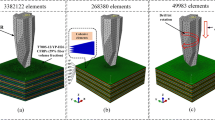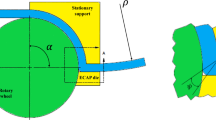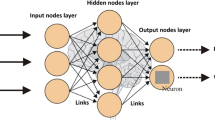Abstract
Engineering plastics have specific properties in strength, hardness, impact resistance, and aging persistence, often used for structural plates and electronic components. However, the holes made by the drilling process always shrink after the cutting heat dispersion due to their high thermal expansion coefficient. Drilling parameters must be discussed thoughtfully especially in the small-hole fabrication to acquire a stable hole quality. This study developed parameter models by the Taguchi-based neural network method to save the experimental resources on the drilling of engineering plastic, polyetheretherketone (PEEK). A three-level full-factorial orthogonal array experiment, L27, was first conducted for minimizing the thrust force, hole shrinkage in diameter, and roundness error. In terms of the network modeling, four variables were designated to the input layer neurons included the three drilling parameters (spindle speed, depth of peck-drilling, feed rate) and the thrust force detected, and that of the output layer neurons were two hole characteristics of diameter shrinkage and roundness. The models were trained by a stepped-learning procedure to expand the network’s field information stage by stage. After three stages of training, the models developed can provide precise simulations for the network’s training sets. For the non-trained cases, the prediction accuracy of the hole’s characteristics discussed was below 1 μm in the drilling of a 1-mm-diameter hole.











Similar content being viewed by others
Data availability
All the data have been presented in the manuscript.
References
Choi YJ, Park MS, Chu CN (2008) Prediction of drill failure using features extraction in time and frequency domains of feed motor current. Int J Mach Tools Manuf 48(1):29–39. https://doi.org/10.1016/j.ijmachtools.2007.08.009
Esim E, Yıldırım Ş (2017) Drilling performance analysis of drill column machine using proposed neural networks. Neural Comput & Applic 28:79–90. https://doi.org/10.1007/s00521-016-2322-8
Roth JT, Djurdjanovic D, Yang X, Mears L, Kurfess T (2010) Quality and Inspection of Machining Operations: Tool Condition Monitoring. ASME J Manuf Sci Eng 132(4):041015–410516. https://doi.org/10.1115/1.4002022
Hyacinth Suganthi X, Natarajan U, Ramasubbu N (2015) A review of accuracy enhancement in midrodrilling operations. Int J Adv Manuf Technol 81:199–217. https://doi.org/10.1007/s00170-015-6900-1
Zerti A, Yallese MA, Meddour I, Belhadi S, Haddad A, Mabrouki T (2019) Modeling and multi-objective optimization for minimizing surface roughness, cutting force, and power, and maximizing productivity for tempered stainless steel AISI 420 in turning operations. Int J Adv Manuf Technol 102:135–157. https://doi.org/10.1007/s00170-018-2984-8
Özden G, Öteyaka MO, Cabrera FM (2021) Modeling of cutting parameters in turning of PEEK composite using artificial neural networks and adaptive-neural fuzzy inference systems. J Thermoplast Compos Mater OnlineFirst. https://doi.org/10.1177/08927057211013070
Daniel SAA, Pugazhenthi R, Kumar R, Vijayananth S (2019) Multi objective prediction and optimization of control parameters in the milling of aluminium hybrid metal matrix composites using ANN and Taguchi-grey relational analysis. Def Technol 15(4):545–556. https://doi.org/10.1016/j.dt.2019.01.001
Yadav RN, Yadava V, Singh GK (2013) Multi-objective optimization of process parameters in Electro-Discharge Diamond Face Grinding based on ANN-NSGA-II hybrid technique. Front Mech Eng 8:319–332. https://doi.org/10.1007/s11465-013-0269-3
Biswas R, Kuar AS, Biswas SK, Mitra S (2009) Artificial neural network modeling of Nd:YAG laser microdrilling on titanium nitride alumina composite. Proc Inst Mech Eng B J Eng Manuf 224(3):473–482. https://doi.org/10.1243/09544054JEM1576
Sarıkaya M, Yılmaz V (2018) Optimization and predictive modeling using S/N, RSM, RA and ANNs for micro-electrical discharge drilling of AISI 304 stainless steel. Neural Comput & Applic 30:1503–1517. https://doi.org/10.1007/s00521-016-2775-9
Kumar SPL, Jerald J, Kumanan S, Prabakaran RA (2014) Review on current research aspects in tool-based micromachining processes. Mater Manuf Process 29(11–12):1291–1337. https://doi.org/10.1080/10426914.2014.952037
Harun MHS, Ghazali MF, Yusoff AR (2017) Analysis of tri-axial force vibration sensors for detection of failure criterion in deep twist drilling process. Int J Adv Manuf Technol 89:3535–3545. https://doi.org/10.1007/s00170-016-9344-3
Singh AP, Sharma M, Singh I (2013) A review of modeling and control during drilling of fiber reinforced plastic composites. Composites: Part B 47:118–125. https://doi.org/10.1016/j.compositesb.2012.10.038
Patra K, Jha AK, Szalay T, Ranjan J, Monostori L (2017) Artificial neural network based tool condition monitoring in micro mechanical peck drilling using thrust force signals. Precis Eng 48:279–291. https://doi.org/10.1016/j.precisioneng.2016.12.011
Efkolidis N, Hernández CG, Talón JH, Kyratsis P (2018) Modelling and prediction of thrust force and torque in drilling operations of Al7075 using ANN and RSM methodologies. J Mech Eng Sci 64(6):351–361. https://doi.org/10.5545/sv-jme.2017.5188
Kharwar PK, Verma RK, Singh A (2020) Neural network modeling and combined compromise solution (CoCoSo) method for optimization of drilling performances in polymer nanocomposites. J Thermoplastic Composite Materials, Online first. https://doi.org/10.1177/0892705720939165
Corne R, Nath C, Mansori MEl, Kurfess T (2017) Study of spindle power data with neural network for predicting real-time tool wear/breakage during inconel drilling. J Manuf Syst 43(2):287–295. https://doi.org/10.1016/j.jmsy.2017.01.004
Soepangkat BOP, Norcahyo R, Khoirul Effendi M, Pramujati B (2020) Multi-response optimization of carbon fiber reinforced polymer (CFRP) drilling using back propagation neural network-particle swarm optimization (BPNN-PSO). Engineering Science and Technology, an International Journal 23(3):700–713. https://doi.org/10.1016/j.jestch.2019.10.002
Ulas HB, Ozkan MT, Malkoc Y (2019) Vibration prediction in drilling processes with HSS and carbide drill bit by means of artificial neural networks. Neural Comput & Applic 31:5547–5562. https://doi.org/10.1007/s00521-018-3379-3
Caggiano A, Angelone R, Napolitano F, Nele L, Teti R (2018) Dimensionality reduction of sensorial features by principal component analysis for ANN machine learning in tool condition monitoring of CFRP drilling. Procedia CIRP 78:307–312. https://doi.org/10.1016/j.procir.2018.09.072
Vrabel M, Maňková I, Beňo J (2016) Monitoring and control of manufacturing process to assist the surface workpiece quality when drilling. Procedia CIRP 41:735–739. https://doi.org/10.1016/j.procir.2015.12.092
Akıncıoğlu S, Mendi F, Çiçek A, Akıncıoğlu G (2013) ANN-based prediction of surface and hole quality in drilling of AISI D2 cold work tool steel. Int J Adv Manuf Technol 68:197–207. https://doi.org/10.1007/s00170-012-4719-6
Cruz CED, Aguiar PR, Machado ÁR, Bianchi EC, Contrucci JG, Neto FC (2013) Monitoring in precision metal drilling process using multi-sensors and neural network. Int J Adv Manuf Technol 66:151–158. https://doi.org/10.1007/s00170-012-4314-x
Mondal N, Mandal S, Mandal MC (2020) FPA based optimization of drilling burr using regression analysis and ANN model. Measurement 152:107327. https://doi.org/10.1016/j.measurement.2019.107327
Ahn Y, Lee SH (2017) Classification and prediction of burr formation in micro drilling of ductile metals. Int J Prod Res 55(17):4833–4846. https://doi.org/10.1080/00207543.2016.1254355
Freeman JA, Skapura DM (1991) Neural networks: algorithms, application, and programming techniques. Addison-Wesley, Massachusetts (chapter 3)
Fowlkes WY, Creveling CM (1984) Engineering methods for robust product design: using taguchi methods in technology and product development. Addison-Wesley, Massachusetts, chapter 4 and chapter 5
Author information
Authors and Affiliations
Contributions
All authors participated in the writing, read and approved the final manuscript.
Corresponding author
Ethics declarations
Ethical approval
Not applicable.
Consent to participate
The authors declare that they all consent to participate this research.
Consent for publication
The authors declare that they all consent to publish the manuscript.
Competing interests
The authors declare no competing interests.
Additional information
Publisher's Note
Springer Nature remains neutral with regard to jurisdictional claims in published maps and institutional affiliations.
Appendices
Appendix 1
Appendix 2
Rights and permissions
About this article
Cite this article
Chang, DY., Lin, CH. & Wu, XY. Modeling for a small-hole drilling process of engineering plastic PEEK by Taguchi-based neural network method. Int J Adv Manuf Technol 119, 5777–5795 (2022). https://doi.org/10.1007/s00170-021-08431-2
Received:
Accepted:
Published:
Issue Date:
DOI: https://doi.org/10.1007/s00170-021-08431-2






